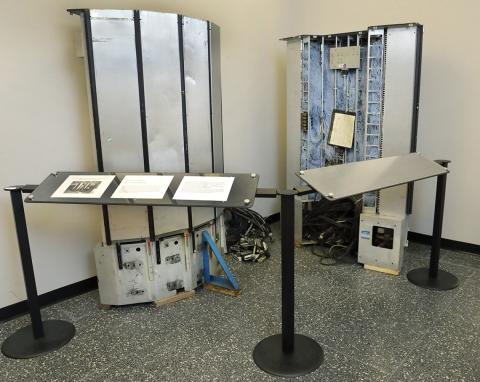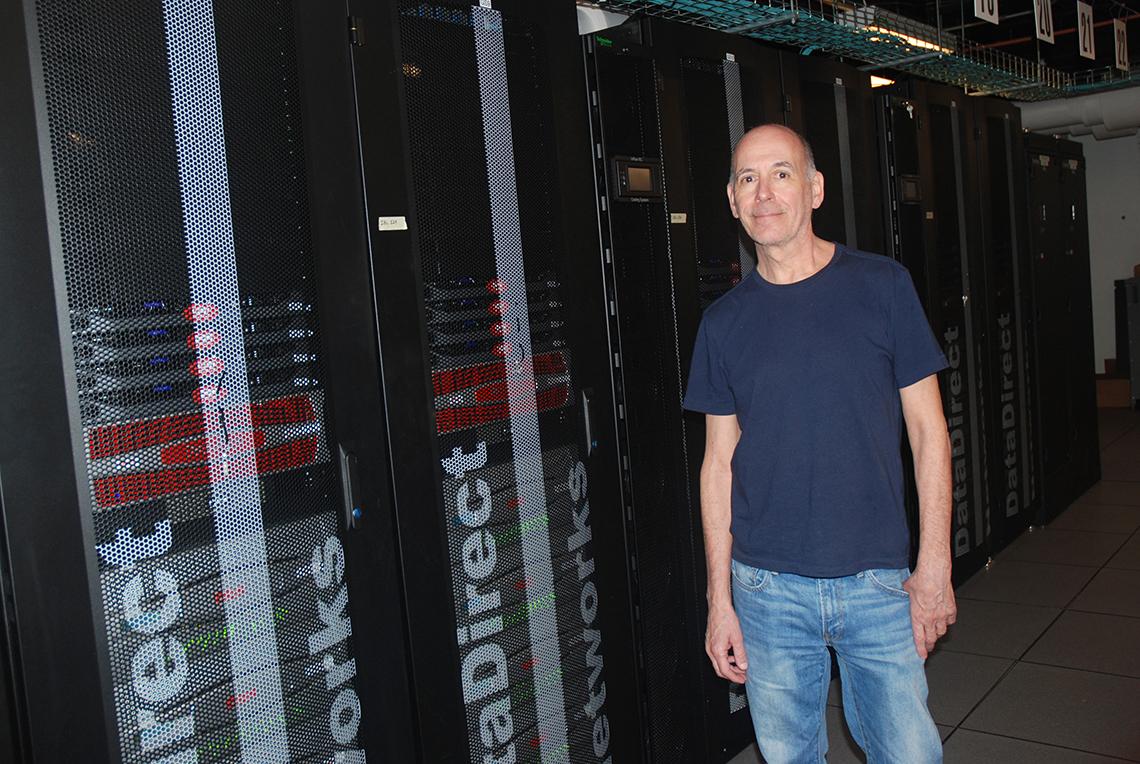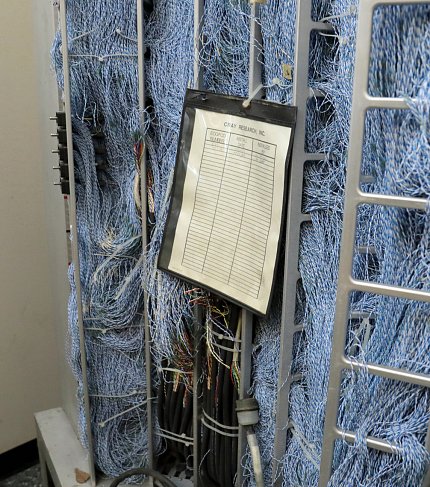NIH Supercomputers Have Come a Long Way

Photo: Ernie Branson
Those tall, gray metal slabs nestled in the corner near the Bldg. 31 C-wing B3 elevators are not remnants of a defunct escalator. They are, in fact, a piece of fascinating history: NIH’s first supercomputer—the Cray X-MP/22.
The Cray on display was the world’s fastest supercomputer from 1983 to 1986, and the first one devoted solely to biomedical research. At capacity, it could perform 400 million calculations per second.
By today’s standards, this Cray may seem rudimentary. But during the time it was used at NIH, from 1986 to 1992, “When you consider the alternative, sitting with paper and pencil or calculator, or even an abacus as at least one scientist did, this computer did quite a lot,” said Michele Lyons, curator, Office of NIH History and Stetten Museum.
The Cray X-MP/22, which had a price tag in the tens of millions of dollars, was the first supercomputer to contain dual processors that could be accessed simultaneously by one program. NCI’s Laboratory of Mathematical Biology used the Cray to study molecular structure and conduct image processing, statistical analysis, basic DNA sequencing and crystallography.
How did this retired supercomputer come to rest in Bldg. 31? NIH’s history office has more than 3,000 historical objects in storage and needs to move much of the collection this year, said Lyons. So they’re trying to get as much on display as possible throughout the campus. Among the gems sitting in storage are paintings of distinguished NIH scientists, spectrometers, microscopes, DNA sequencers, an old giant centrifuge, lab clothing and hundreds of 20th century manuals.

When buildings are about to be demolished or renovated, history office staff swoop in to save as many original, unique items as they can. When Bldg. 2 was demolished, Lyons and her colleagues took enough well-preserved equipment to reconstruct a vintage laboratory.
“My dream is to put in a complete lab exhibit from each decade on each floor of Bldg. 31,” said Lyons.
Walk up to the Bldg. 31 Cray and you’ll see all the wiring, the computer boards soldered together and the cooling system. The history office plans to enhance the exhibit with a mirror, so passersby can see more of the internal wiring, an updated plaque and the original computer work benches. The office also has the old punch cards and paper tape, as well as drawings of the local network that connected computer terminals around campus.
NIH’s current supercomputer is massive by comparison and operates at a mindboggling speed. While the Cray performed at 133 megaflops per second, the big beast known as Biowulf performs at 2 petaflops, or 2 thousand-trillion floating-point operations per second.
Its tall towers filling a large room in Bldg. 12, the Biowulf cluster is 15 million times faster than the Cray X-MP/22, said Dr. Steven Fellini, the supercomputer’s systems architect and member of CIT’s high-performance computing team.

Photo: Dana Talesnik
NIH’s intramural program uses the powerful cluster in large part for genomics studies—advanced DNA sequencing, whole genome analysis—as well as statistics, imaging and molecular modeling. Other NIH investigators use Biowulf to analyze brain MRIs, identify cancer targets, create algorithms to study disease and simulate the spread of pandemics.
“The Biowulf cluster is allowing scientists to do work they couldn’t do otherwise,” said Fellini.
During a recent winter afternoon, at 70 percent capacity, Biowulf was running 17,000 simultaneous jobs among 213 unique users across 20 institutes, with 3,000 jobs in the queue.
In fact, the Top 500 organization recently ranked Biowulf the 66th most powerful commercially available computer system in the world.
Almost 20 years ago, Biowulf began as a couple dozen boxes on a shelf and has expanded in phases. Biowulf now consists of many rows of computer towers, each with a customized refrigerator-like cooling system, all connected by 25 kilometers of fiber optic cable.
Fellini started his NIH career in 1980, working as a postdoc in a biochemistry lab. “I was using computers to do my data analysis and one thing led to another,”
he said.

Photo: Dana Talesnik
Fellini continues to lead the team that built Biowulf from the ground up. In just over 3 years, Biowulf’s computing capacity increased by 400 percent, from 18,000 to 92,300 core processors. The fifth expansion phase, slated for early next year, will add another 30,000 cores that will be housed in another room in Bldg. 12.
“Compared to the Cray, the Biowulf is actually simpler in some ways,” said Fellini. “The Cray was hand-wired. Biowulf uses commodity components in its circuitry. It’s the equivalent of 4,000 computers comprising 90,000 core processors. The Cray X-MP had only 2.”
For anyone wondering where to unload biomedical relics, NIH’s history office accepts donations; visit https://history.nih.gov/museum/donate.html. Lyons said the office is particularly interested in equipment from the 1980s to 2000s. They also regularly get requests for manuals, which sometimes are the only way to learn how older machines worked. The office has a large collection of 20th century manuals, all of which have been digitized.
“I’d be interested to know what’s the oldest computer still being used on campus today,” said Lyons. “And, if that person is planning on getting rid of it, we’re interested!”
